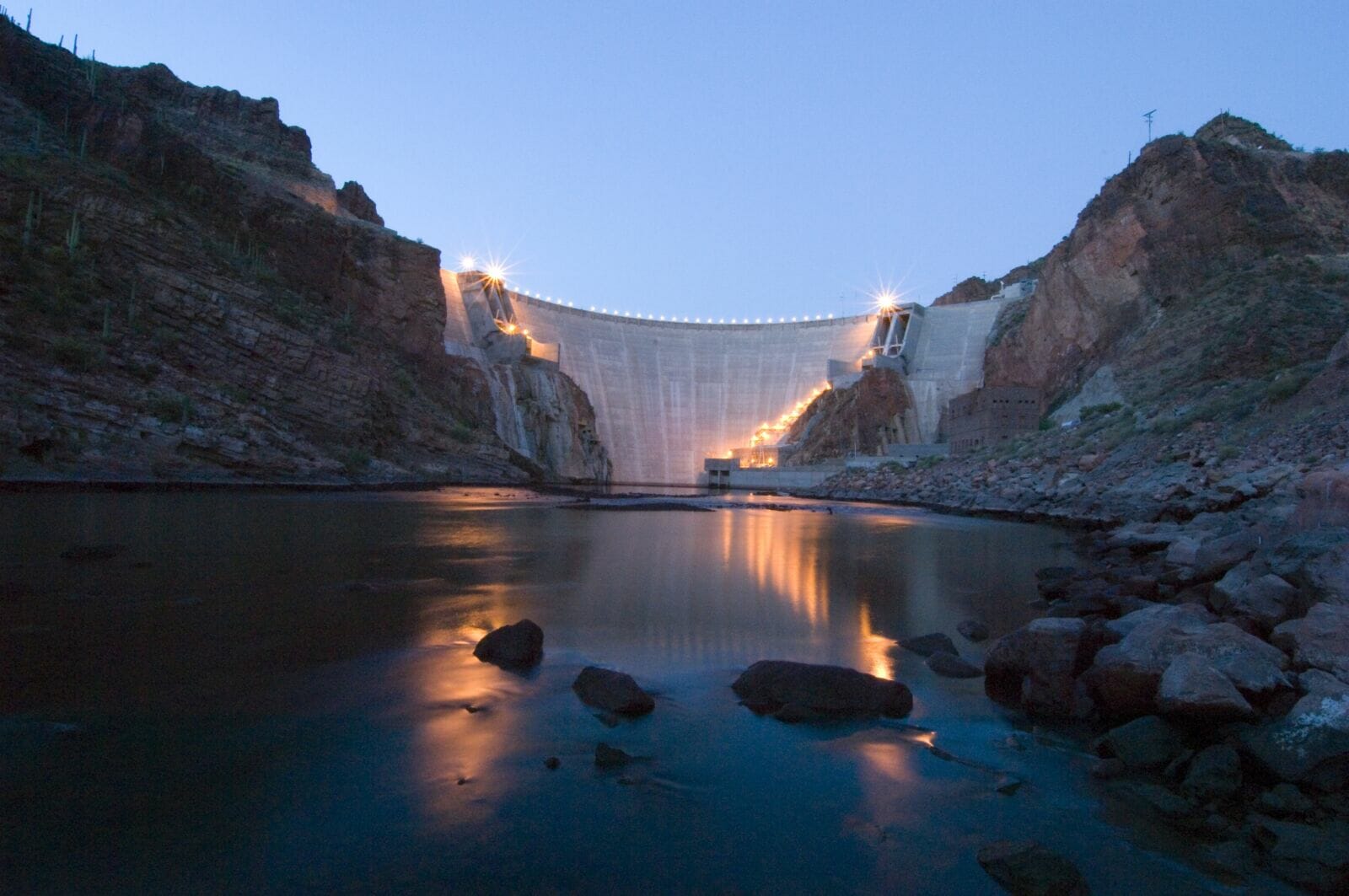Long before dams and large-scale plumbing projects brought water into the Valley, the Hohokam people carved out hundreds of miles of canals to irrigate their crops with water from the Salt River. For communities living in a desert, then and now, the reliable availability of water is the paramount organizing principle for collective action. Arizona is amidst a historic drought and water supplies from the Colorado River continue to dwindle, but state and federal legislators have long prepared for such a crisis and continue to act today. So, what is the truth about the Arizona water supply?
DEEPER DIVE: Here’s a look at the future of water in Arizona
READ ALSO: Some fast facts to know about the Arizona water supply
“Water, as a binding element and defining feature of our civilization necessarily involves government,” says Grady Gammage Jr., founding member of Gammage and Burnham. “Water has to be a shared, cooperative enterprise in a place where it doesn’t rain very much. And that history gave us a legacy of bipartisan and nonpartisan cooperation about the one issue that mattered the most, which is water.”
Over the decades, Arizona has banked somewhere between 12- and 13-million-acre-feet of water underground through directly or indirectly recharging aquifers, and by paying farmers to use Central Arizona Project (CAP) water instead of pumping groundwater. That is enough water to sustain Phoenix and Tucson’s urban needs for a decade.
“For it to be 10 years’ worth of water, the Colorado River and Salt River would have to dry up, all groundwater pumping would have to stop, and it’d have to quit raining,” Gammage says. “Then it’s enough for about 10 years.”
Gammage worries that because Arizona has been successful at water management for so long that some have begun to take it for granted. The government, he continues, has made massive investments between the Salt River Project (SRP), CAP and developing groundwater supplies to make life in the desert feasible.
“There’s been a couple $100 billion spent in today’s dollars making [the growth of Arizona] possible — maybe more,” Gammage says. “And we’re going to have to do another round of that, whether it’s desalination, compensating farmers to quit farming and let that water move to urban uses, or some other combination — several billion dollars are needed to keep sustaining [Arizona’s growth], and it’s going to have to be spent by government.”
Federal funding
Senators Kyrsten Sinema and Mark Kelly have been advocating for measures that will shore up Arizona’s water supplies. Kelly spearheaded a piece of legislation called the Colorado River Indian Tribes Water Resiliency Act, which authorizes Colorado River Indian Tribes lease, exchange, store or conserve portions of their decreed water rights to off-Reservation users.
“In the face of historic drought and record low water levels in the Colorado River, Arizona’s tribal communities know just how important securing water resources is to the future of our state. Thanks to our bipartisan, common-sense legislation, the Colorado River Indian Tribes can now fully exercise and lease their water rights — improving drought resiliency and fueling economic growth across the state,” Kelly says.
Both senators voted for the Infrastructure Investment and Jobs Act (IIJA), also known as the Bipartisan Infrastructure Law, and the Inflation Reduction Act (IRA), which together allocated billions for drought relief and water infrastructure for states across the Western U.S.
“When I was writing the Bipartisan Infrastructure Law in 2021, I ensured there was over $8.2 billion included in that package specifically for repairs and improvements to outdated water systems, and for water storage,” Sinema explains. “When you combine that with the $4 billion dollars that I negotiated for inclusion in the Inflation Reduction Act, it’s nearly $13 billion of funding specifically for the American West.”
To ensure that federal funds are used effectively, Sinema created a Water Advisory Council, which gathers water experts from agriculture, tribal, conservation, academic and business communities across Arizona.
During the council’s meeting on April 6, members presented ideas to the Department of the Interior and Bureau of Reclamation for future infrastructure projects to be funded by the $4 billion set aside for water conservation in the IRA.
That same day, Gila River Indian Community Governor Stephen Roe Lewis announced that the Bureau of Reclamation has allocated $83 million from the IIJA for a reclaimed water pipeline running from Mesa onto the reservation.
From funds secured in the IRA, the Gila River Indian Community and Bureau of Reclamation agreed that the Community will conserve up to 125,000-acre-feet of water per year for three years at a price of $400 per acre-foot. If fully implemented, this would total $150 million over three years.
“Half a million Arizonans will have access to water they wouldn’t have otherwise over these three years,” Sinema says. “This agreement is the greatest contribution to water conservation in all of the Colorado River Basin states.”
In search of sources
In 2022, then-Gov. Doug Ducey signed Senate Bill 1740, which tasked the Water Infrastructure Finance Authority (WIFA) to spend $1 billion over three years to shore up Arizona’s water supplies.
“[Prior to the legislation] we were largely focused within the state, looking at small and medium-sized wastewater utilities,” explains Chuck Podolak, director of WIFA. “The legislature plans to give us $1 billion over a three-year period and told us at least 75% [of that money] has to be focused on projects that bring new water from outside of the state.”
One potential source that has drawn attention is building a desalination plant on the Gulf of California and pumping water north across the U.S.-Mexico border into Arizona. Another option for desalination would be along the California coast, though regulators in the state voted down a project in 2022. There’s even talk of bringing water in from the Midwest, but Podolak says there’s significant costs involved, along with regulatory and political barriers.
Still, Podolak sees potential in collaboration with Arizona’s regional neighbors. Much of Southern California’s wastewater ends up in the ocean, rather than being treated and reused as effluent. If the Los Angeles area utilized effluent, more Colorado River could be used elsewhere, Podolak explains.
“We’ve been talking with [CAP)], [the Arizona Department of Water Resources (ADWR)] and the Metropolitan Water District of Southern California about a [wastewater treatment] project that they’re working on,” he says.
Leslie Meyers, chief water executive and associate general manager of water resources at SRP, notes that effluent is a small-yet-important part of Arizona’s current water portfolio. Groundwater still accounts for a large portion of the water used in the state, followed by Colorado River and SRP water.
“The Colorado River makes up about 36% of our supply in Arizona, and the Salt River Project is in the 15%-18% of the range,” she says. “About 5% of our supply comes from effluent and the balance still comes from groundwater.”
Direct potable reuse, or wastewater that’s treated up to standards safe for human consumption, makes the concept of bringing water from outside the state more viable.
“If you bring in costly water and you can reuse it multiple times, that changes the overall economics,” Podolak says. “People ask, ‘Does it make sense to bring water in from Mexico, the Midwest or the coast of California?’ If you can inject that water into a system with direct potable reuse, that really helps.”
According to the Arizona Department of Environmental Quality, direct potable reuse is currently allowed under the agency’s rules, but “additional regulatory specificity is needed to ease water suppliers’ ability to engage in potable reuse.” The rulemaking process is still underway.
Infrastructure
Popular culture occasionally lampoons Phoenix as an arid wasteland that only the foolish would want to live in. In an episode of “King of the Hill” where the characters visit Phoenix in the summer, one of them quips, “This city should not exist. It’s a monument to man’s arrogance.”
Brenda Burman, general manager of CAP, sees it differently. “People have existed here for over 10,000 years, and that’s because five rivers come together in the Phoenix Valley,” she says. “What we’ve been smart enough to do as settlers is harness those rivers so that they could deliver in summer when we really needed the water, even though the runoff [from snow melt] was in spring.”
Infrastructure, such as the CAP canal system and SRP’s various dams, has allowed Phoenix to grow into the nation’s fifth largest city, but more investments need to be made. Because Northern Arizona had a snowy winter this year, Meyers explains that water is being released from Horshoe and Bartlett Dams to make room for when that snowpack melts and flows down the Verde River.
“We want to be able to capture that water and use it,” Meyers says. “That’s just one of the benefits of constructing a new dam or modifying Bartlett Dam, and we’ve been looking into doing that. We’ve already done an appraisal study with the Bureau of Reclamation.”
When water flows off the Verde watershed, the first place it stops is Horseshoe Dam — upstream of Bartlett Dam — and does so with immense speed. The cascade of water brings with it silt and other sedimentation, which has caused Horseshoe Dam to lose about a third of its capacity.
“We found out in that initial study that our best option is to build a bigger Bartlett Dam downstream and recover the capacity there,” Meyers continues. “That way in a situation like this, we wouldn’t have to be releasing water off the Verde. We could develop it, store it and deliver it.”
With the appraisal study complete, the next step is a feasibility analysis, which requires federal authority and funding. The IIJA provided that authorization along with $5 million for the analysis.
“Then this year, we were allocated another $5 million in federal funding for the Bartlett Dam study,” Meyers says. “After that, we’ll have to seek authorization to construct and look for either federal funding, local funding, or some combination of both.”
Another big piece of infrastructure is a new connection between SRP and CAP’s canal systems.
“When CAP was first built, there was a CAP-SRP interconnect, because everyone thought, ‘We’re going to have so much extra CAP water, it’ll be good to deliver it into the SRP system,’” Meyers concludes. “Today, we need to do the reverse. We’re looking at developing an SRP-CAP interconnect to help alleviate some of the reductions people are having on their Colorado River water supply.”




